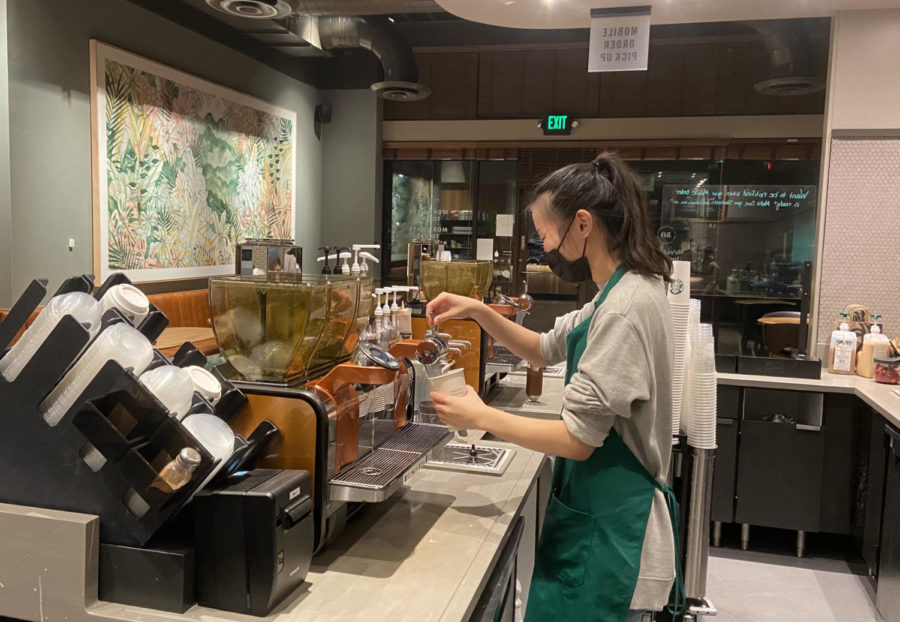Opinion: Serving at Starbucks – the other side of the counter
For every customer, I’m asked to repeat the same set of words with a smile.
“Thank you for choosing our Starbucks! I’m Jo; I’ll take your order when you’re ready,”
“Welcome in! What can I get started for you today?”
“Your total is… Would you like some straws or napkins?”
Maybe I’ll even add a “Hope you have a nice day!” if they’re nice.
Being relatively new to working at Starbucks, my first job, I’m still learning how to effectively communicate with customers while juggling multiple tasks at once. Having a routine set of words allows me to interact with people with ease, but it does not prepare me for the rare number of people who express their anger easily.
I dealt with this firsthand while working a drive-thru shift on a Sunday morning, which happened to be my very first time working on drive-thru handouts — the position where the barista gives customers their drink and takes payments. Every worst possible scenario was occuring that day: the cash register was broken, computers were malfunctioning, none of our breakfast items were in stock, cold brew was sold out and we were severely understaffed. Each customer was having to deal with a miserably long 35-minute wait that morning, and the burden of dealing with angry drive-thru customers fell on me.
For this special situation, I had to change my dialogue. For the next two hours, I repeated the following words to every customer: “I’m so sorry about that wait: we’re currently dealing with shortages and our computer systems are malfunctioning. Your total is…”
I was met with many different complaints, for which I thoroughly explained all of the issues that the store was experiencing and apologized for the inconvenience. After a grueling couple of hours, my shift supervisor told me to go take a quick break. But before she sent me on my way, she stopped me and said, “By the way Jo, you don’t have to apologize so much.”
I didn’t realize what she meant at the moment, but it took me a couple days to fully realize the meaning behind her words. First of all, I realized an apology is quite useless: it isn’t going to magically bring back the 35 minutes that were lost, nor will it fix any issues. But more importantly, I realized that over-apologizing for inconveniences may appear to be helping the situation in the short term, but in reality, it’s covering up an underlying issue. It establishes a culture of customers feeling entitled to our service, and constantly facing customers like that can take a toll on employees’ mental health.
Any food industry employee, regardless of profession, is responsible for meeting a customer’s needs. But when obstacles are in the way and meeting such needs become considerably difficult, it is not an excuse for customers to completely disregard common courtesy and respect — something many customers fail to realize. After all, the people who are taking your orders, refilling your drinks and preparing your food are real humans who are trying to work through issues, too. The pandemic has left devastating effects in every sector of the economy, including food services. Employees, such as myself, are being scheduled to work outside of our available times, which is exhausting enough on its own. When dealing with disrespectful customers on top of this, work becomes more difficult than it should be.
Interactions with rude customers is inevitable for any employee who works in the service industry, but that culture is able to change. Just as it’s a part of an employee’s job to respect the customers, the customers have a job to reciprocate that courtesy back. For me, that change starts with greeting people with words other than an apology and kindly asking for their cooperation instead.

Senior Yunseo Jo is a reporter and this is her first year on staff. She is a dog whisperer who enjoys reading and digital art.




Abdul Lodhia • Aug 23, 2024 at 5:50 AM
As a huge Starbucks fan, I’m really excited about the new fall menu and merchandise lineup! The return of the Pumpkin Spice Latte is always a highlight, but I think the introduction of the non-dairy Iced Pumpkin Cream Chai Tea Latte is a game-changer for those who prefer plant-based options. Also, the Apple Crisp Oatmilk Macchiato sounds like the perfect blend of sweet and spicy for the cooler months.
I recently wrote an in-depth article covering the top 10 must-have Starbucks Fall 2024 items, from drinks to exclusive merchandise. If you’re curious about what’s new and what’s returning, you can check it out h
Trendingcoolnews. com/10-must-have-starbucks-fall-2024-treats/ I’d love to hear your thoughts on these seasonal offerings!